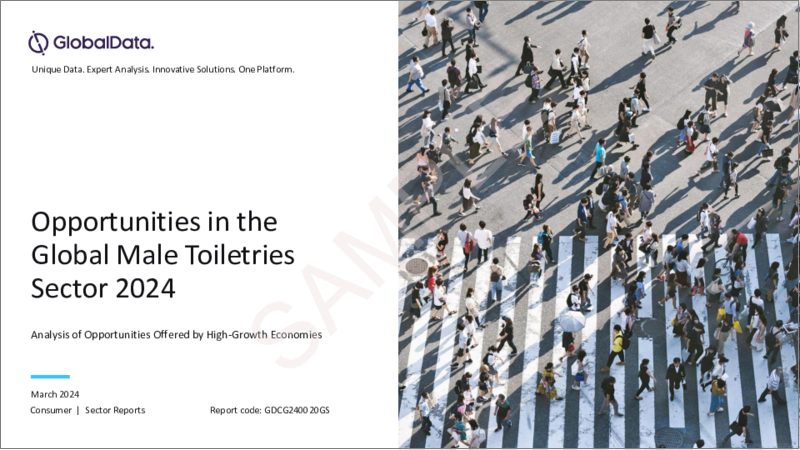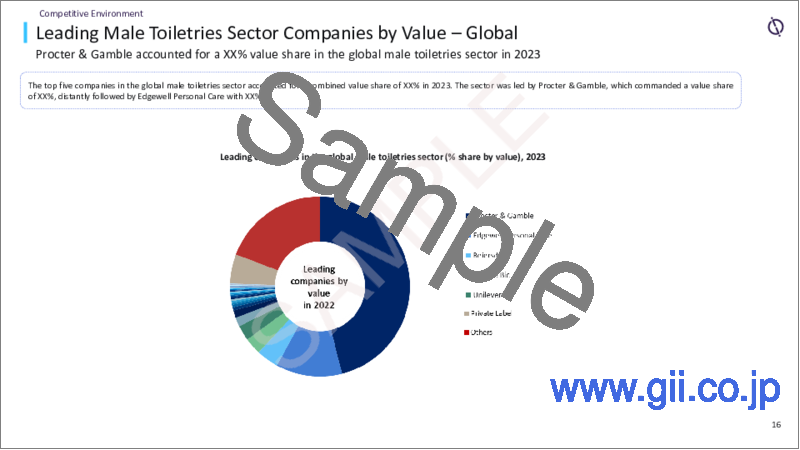|
|
市場調査レポート
商品コード
1464594
世界の男性用トイレタリー部門における機会(2024年)Opportunities in the Global Male Toiletries Sector 2024 |
||||||
カスタマイズ可能
適宜更新あり
|
|||||||
| 世界の男性用トイレタリー部門における機会(2024年) |
|
出版日: 2024年03月28日
発行: GlobalData
ページ情報: 英文 155 Pages
納期: 即納可能
|
- 全表示
- 概要
- 図表
- 目次
世界の男性用トイレタリー部門の市場規模は、2023年に179億米ドルであり、2028年に210億米ドルに達し、2023年~2028年にCAGRで3.2%の成長が予測されます。数量ベースでは、この部門は2023年の46億個から2028年に51億個に成長すると予測されます。2023年の世界の男性用トイレタリー部門の最大の地域は南北アメリカで、金額シェアは44.5%であり、西欧が28.9%で続きます。2023年、男性用使い捨てカミソリ・刃が金額ベースでも数量ベースでも世界最大のカテゴリとなり、それぞれ63.8%と75.7%のシェアを占めました。アジア太平洋の男性用トイレタリー部門は、予測期間に4.8%という最速の金額CAGRを記録する見込みです。
消費者の健康志向の高まりに伴い、男性用トイレタリー製品においても天然成分や植物由来成分の需要が高まっています。消費者は有害物質を含まない成分を求めており、パラベン、ラウレス硫酸ナトリウム、硫酸塩などの有害な化学品を避けています。その結果、メーカー各社は天然由来の安全な成分を使用した男性用トイレタリー製品を開発しています。男性用トイレタリー業界は、表示に関する規制が厳しく、メーカーには良質な成分を配合したクリーンラベルの商品を製造することが求められています。消費者は明確な情報を提供する製品を選ぶようになっています。そのため、各ブランドは製品使用の安全性を高めるため、パックラベル上での情報伝達の強化に注力しています。
当レポートでは、世界の男性用トイレタリー部門について調査し、各地域の業界規模、成長促進要因、最新動向、将来の抑制要因などを分析しています。
目次
- エグゼクティブサマリー
- 部門の概要
- 現在のシナリオと将来の見通し
- 世界の男性用トイレタリー部門の概要 - 成長要因、最新の発展、将来の抑制要因は何か
- 地域の男性用トイレタリー製品の概要 - 成長要因、最新の発展、将来の抑制要因は何か
- 世界の男性用トイレタリー製品セグメントにおける主な課題
- C&T金額シェアパターンの変化
- C&T業界全体における金額消費レベルの変化(2023年~2028年)
- 消費パターンの変化の理由
- 潜在力の高い国の特定:地域別
- リスクリターン分析に基づく10ヶ国の分析
- (市場の評価、経済発展、社会人口学的要因、ガバナンス指標、技術インフラ)
- 国の詳細
- 潜在力の高い国の分析
- 将来の見通し
- 競合環境
- 主要企業(金額) - 世界
- 主要企業とブランドのシェアの分析 - 世界
- 主要企業とブランドのシェアの分析:地域別
- 競合情勢 - 市場の分析
- プライベートブランドの市場シェア
- プライベートブランドのシェアの分析:地域別
- プライベートブランドのシェアの分析:カテゴリ別
- 主な流通チャネル
- 主な流通チャネルのシェア - 世界/地域レベル
- 主な包装形式
- 成長分析:主なパック材料、パックタイプ別
- 成長分析:クロージャータイプ、一次外装タイプ別
- 業界指標
- 世界の特許申請
- 世界の求人分析
- 世界の取引
付録
List of Tables
- Change in value share levels in the overall C&T industry, 2023-28
- Change in consumption levels - Asia-Pacific, 2018-28
- Change in consumption levels - MEA, 2018-28
- Change in consumption levels - The Americas, 2018-28
- Change in consumption levels - Western Europe, 2018-28
- Change in consumption levels - Eastern Europe, 2018-28
- Identifying high-potential countries, risk-reward analysis - Asia-Pacific
- Identifying high-potential countries, risk-reward analysis - MEA
- Identifying high-potential countries, risk-reward analysis - The Americas
- Identifying high-potential countries, risk-reward analysis - Western Europe
- Identifying high-potential countries, risk-reward analysis - Eastern Europe
- Australia: Volume share analysis of top eight cities by category (%), 2023
- Japan: Volume share analysis of top 10 cities by category (%), 2023
- Mexico: Volume share analysis of top 10 cities by category (%), 2023
- Peru: Volume share analysis of top nine cities by category (%), 2023
- UK: Volume share analysis of top 10 cities by category (%), 2023
- Austria: Volume share analysis of top five cities by category (%), 2023
- Romania: Volume share analysis of top eight cities by category (%), 2023
- Hungary: Volume share analysis of top five cities by category (%), 2023
- Top five companies' shares by brand (in value terms) in global male toiletries sector, 2023
- Top five companies' shares by brand (in value terms) in Asia-Pacific male toiletries sector, 2023
- Top five companies' shares by brand (in value terms) in MEA male toiletries sector, 2023
- Top five companies' shares by brand (in value terms) in the Americas male toiletries sector, 2023
- Top five companies' shares by brand (in value terms) in Western European male toiletries sector, 2023
- Top five companies' shares by brand (in value terms) in Eastern European male toiletries sector, 2023
- Key brands - aftershaves & colognes, 2023
- Key brands - men's disposable razors & blades, 2023
- Key brands - post-shave cosmetics - men's, 2023
- Key brands - pre-shave cosmetics - men's, 2023
- Private label's value and share by region, 2018-23
- Private label's value and share by category, 2023
- Leading distribution channels by region (% share by value), 2023
List of Figures
- Key categories by value and volume, 2023-28 - Global
- Key categories by value and volume, 2023-28 - Asia-Pacific
- Key categories by value and volume, 2023-28 - MEA
- Key categories by value and volume, 2023-28 - The Americas
- Key categories by value and volume, 2023-28 - Western Europe
- Key categories by value and volume, 2023-28 - Eastern Europe
- Australia: Category share
- Australia: Consumption by age group
- Australia: Consumption by education
- Australia: Consumption by degree of urbanization
- Australia: Volume share analysis of top eight cities (%), 2018-23
- Vietnam: Category share
- Japan: Category share
- Japan: Consumption by age group
- Japan: Consumption by education
- Japan: Consumption by degree of urbanization
- Japan: Volume share analysis of top 10 cities (%), 2018-23
- Mexico: Category share
- Mexico: Consumption by age group
- Mexico: Consumption by education
- Mexico: Consumption by degree of urbanization
- Mexico: Volume share analysis of top 10 cities (%), 2018-23
- Peru: Category share
- Peru: Consumption by age group
- Peru: Consumption by education
- Peru: Consumption by degree of urbanization
- Peru: Volume share analysis of top nine cities (%), 2018-23
- UK: Category share
- UK: Consumption by age group
- UK: Consumption by education
- UK: Consumption by degree of urbanization
- UK: Volume share analysis of top 10 cities (%), 2018-23
- Austria: Category share
- Austria: Consumption by age group
- Austria: Consumption by education
- Austria: Consumption by degree of urbanization
- Austria: Volume share analysis of top five cities (%), 2018-23
- Romania: Category share
- Romania: Consumption by age group
- Romania: Consumption by education
- Romania: Consumption by degree of urbanization
- Romania: Volume share analysis of top eight cities (%), 2018-23
- Hungary: Category share
- Hungary: Consumption by age group
- Hungary: Consumption by education
- Hungary: Consumption by degree of urbanization
- Hungary: Volume share analysis of top five cities (%), 2018-23
- Morocco: Category share
- Morocco: Consumption by age group
- Leading companies in the global male toiletries sector (% share by value), 2023
- Key pack material volume share (%), 2023
- Annual volume growth by pack material (%), 2018-28
- Key pack type volume share (%), 2023
- Annual volume growth by pack type (%), 2018-28
- Key closure type volume share (%), 2023
- Annual volume growth by closure type (%), 2018-28
- Key primary outer type volume share (%), 2023
- Annual volume growth by primary outer type (%), 2018-28
- Global C&T industry patent filings, 2023
- C&T industry patent filings by leading companies, 2023
- Total C&T industry patent filings for key markets, 2023
- Total job postings in C&T industry by company, 2023
- Job postings in C&T industry by theme, 2023
- Deals in C&T industry by geography, 2023
The global male toiletries sector was valued at $17.9 billion in 2023 and is forecast to record a CAGR of 3.2% during 2023-28, reaching $21 billion in 2028. In volume terms, the sector is forecast to grow from 4.6 billion units in 2023 to 5.1 billion units in 2028. The Americas represented the largest region for the global male toiletries sector in 2023, with a value share of 44.5%, followed by Western Europe with 28.9%. In 2023, men's disposable razors & blades was the largest category in both value and volume terms globally, with shares of 63.8% and 75.7%, respectively. The male toiletries sector in Asia-Pacific is set to record the fastest value CAGR at 4.8% over the forecast period.
Provides an overview of current male toiletries scenario regarding the future outlook in terms of ingredients, product claims, labeling, distribution, and packaging. The analysis also covers regional overview across five regions - Asia-Pacific, Middle East and Africa, Americas, Western Europe, and Eastern Europe - highlighting industry size, growth drivers, latest developments, and future inhibitors for the regions.
With growing health and wellness among consumers, there has been an increase in demand for natural and plant-based ingredients in male toiletries products. Consumers are looking for toxin-free ingredients and are avoiding harmful chemicals such as parabens, Sodium laureth sulfate, and sulfates. As a result, manufacturers are formulating male toiletries products using naturally sourced and safe ingredients. The male toiletreis industry is highly regulated in terms of labeling, while manufacturers are expected to produce clean-label items with good-quality ingredient formulations. Consumers are increasingly opting for products that provide clear information. Therefore, brands are focusing on strengthening their communication on pack labels, to increase safety in product usage.
Scope
This report brings together multiple data sources to provide a comprehensive overview of the global male toiletries sector, analyzing data from 108 countries. It includes analysis on the following -
Sector overview: Provides an overview of the current sector scenarios in terms of ingredients, manufacturer claims, labeling, and packaging. The analysis also provides a regional overview across five regions-Asia-Pacific, Middle East and Africa (MEA), the Americas, Western Europe, and Eastern Europe-highlighting sector size, growth drivers, the latest developments, and future challenges for each region. This data includes both on-trade and off-trade data.
Change in consumption: Provides an overview of consumption changes in the overall cosmetics and toiletries (C&T) industry, including male toiletries products, over 2018-28 at global and regional levels.
High-potential countries: Provides risk-reward analysis of the top high-potential countries in each region based on market assessment, economic development, governance indicators, sociodemographic factors, and technological infrastructure.
Country and regional analysis: Provides a deep-dive analysis of 10 high-potential countries covering value growth during 2023-28, key challenges, consumer demographics, and key trends. It also includes regional analysis covering the future outlook for each region.
Competitive environment and brand shares: Provides an overview of the leading companies and brands at global and regional levels. Market shares of brands and private labels in each region are also detailed.
Key distribution channels: Provides an analysis of the leading distribution channels in the global male toiletries sector in 2023. It covers "dollar stores", variety stores and general merchandise retailers, cash & carries and warehouse clubs, chemists/pharmacies, convenience stores, department stores, direct sellers, e-retailers, health & beauty stores, hypermarkets & supermarkets, parapharmacies/drugstores, and others.
Packaging analysis*: The report provides percentage share (in 2023) and growth analysis (during 2023-28) for various pack materials, pack types, closures, and primary outer types based on volume sales of male toiletries products.
Reasons to Buy
Manufacturers and retailers seek latest information on how the market is evolving to formulate their sales and marketing strategies. There is also demand for authentic market data with a high level of detail. This report has been created to provide its readers with up-to-date information and analysis to uncover emerging opportunities of growth within the sector in the region
The report provides a detailed analysis of the countries in the region, covering the key challenges, competitive landscape and demographic analysis, that can help companies gain insight into the country specific nuances
The analysts have also placed a significant emphasis on the key trends that drive consumer choice and the future opportunities that can be explored in the region, than can help companies in revenue expansion
To gain competitive intelligence about leading brands in the sector in the region with information about their market share and growth rates
Table of Contents
Table of Contents
- Executive Summary
- Sector Overview
- Current Scenario and Future Outlook
- Global Male Toiletries Sector Overview - What Are the Growth Factors, Latest Developments, and Future Inhibitors?
- Regional Male Toiletries Overview - What Are the Growth Factors, Latest Developments, and Future Inhibitors?
- Key Challenges in the Global Male Toiletries Sector
- Shift in C&T Value Share Patterns
- Change in Value Consumption Levels in the Overall C&T Industry, 2023-28
- Reasons for Shift in Consumption Patterns
- Identifying High-Potential Countries by Region
- Analysis of 10 Countries on the Basis of Risk-Reward Analysis
- (Market Assessment, Economic Development, Sociodemographic Factors, Governance Indicators, and Technological Infrastructure)
- Country Deep Dive
- High-Potential Country Analysis
- Future Outlook
- Competitive Environment
- Leading Companies by Value - Global
- Leading Companies and Brands Share Analysis - Global
- Leading Companies and Brands Share Analysis by Region
- Competitive Landscape - Market Analysis
- Market Share of Private Labels
- Private Labels' Share Analysis by Region
- Private Labels' Share Analysis by Category
- Key Distribution Channels
- Share of Key Distribution Channels - Global and Regional Level
- Key Packaging Formats
- Growth Analysis by Key Pack Material and Pack Type
- Growth Analysis by Closure Type and Primary Outer Type
- Select Industry Metrics
- Global Patent Filings
- Global Job Analytics
- Global Deals
Appendix
- Definitions
- About GlobalData






